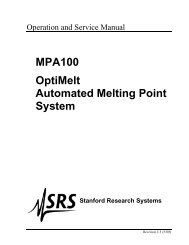Quartz Crystal Microbalance Theory and Calibration - Stanford ...
Quartz Crystal Microbalance Theory and Calibration - Stanford ...
Quartz Crystal Microbalance Theory and Calibration - Stanford ...
Create successful ePaper yourself
Turn your PDF publications into a flip-book with our unique Google optimized e-Paper software.
www.thinkSRS.com<br />
The QCM100 provides a Frequency output port (BNC).<br />
Virtually any commercially available frequency counter can measure the<br />
frequency of the 2.4Vpp square wave in 50Ω provided by the QCM100<br />
Frequency Output. Counters are relatively simple to set-up <strong>and</strong> read via their<br />
computer interfaces.<br />
Frequency Counter Selection Criteria<br />
The selection criteria for a frequency counter for QCM application include:<br />
resolution, speed, time-base stability, computer interfaces <strong>and</strong> software drivers.<br />
Careful selection is required, otherwise the frequency counter may degrade the<br />
quality of mass measurements.<br />
The table below lists the typical characteristics of the frequency signal from the<br />
QCM100 controller for a crystal in water.<br />
Item Description Typical Value<br />
1 Frequency 5 ±0.01 MHz<br />
2 Waveform (into 50Ω) 2.4V square wave<br />
3 Stability (second to second) 0.002 Hz<br />
4 Stability (minute to minute) 0.10 Hz<br />
5 Temperature coefficient 8 Hz / ºC<br />
6 Frequency/mass coefficient 0.057 Hz / (ng/cm 2 )<br />
Many of the frequency counter’s characteristics are determined by its time-base:<br />
if the time-base changes frequency by 10ppm the reported values will also<br />
change by 10ppm. While the accuracy of the counter’s time-base is not<br />
particularly important, the stability of the time-base is critically important as<br />
variations in the time-base will be indistinguishable from changes in accumulated<br />
mass on the surface of the crystal. Often manufacturers will specify accuracy <strong>and</strong><br />
aging but do not specify short-term stability. In virtually all counters the short-term<br />
stability will improve if they are allowed to warm-up for an extended period of<br />
time. To avoid degrading frequency measurements, the time-base should have a<br />
1 second stability of better than .002Hz / 5MHz or 1:4·10 -10 .<br />
The speed/resolution of a counter is also important: the accumulated mass can<br />
change rapidly in a typical QCM measurement, <strong>and</strong> it is desirable to make<br />
frequency measurements with a resolution of 1:10 -10 in a one second interval so<br />
as not to significantly degrade the mass resolution of, or add noise to, the<br />
measurement. Simply counting cycles of the frequency output over a one second<br />
interval can not provide resolution better than 1: 5·10 6 , <strong>and</strong> so a more elaborate<br />
<strong>Stanford</strong> Research Systems (408)744-9040

















